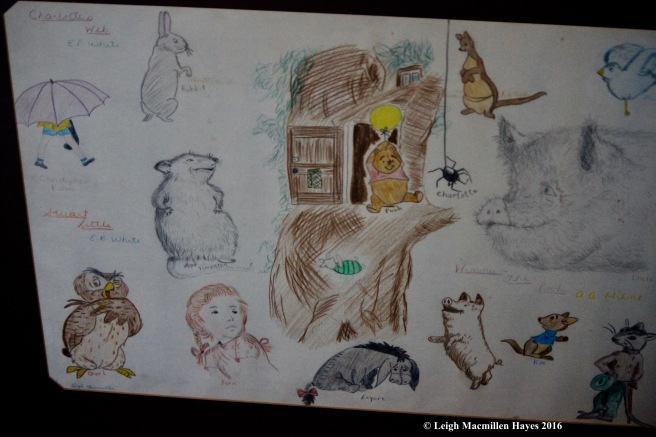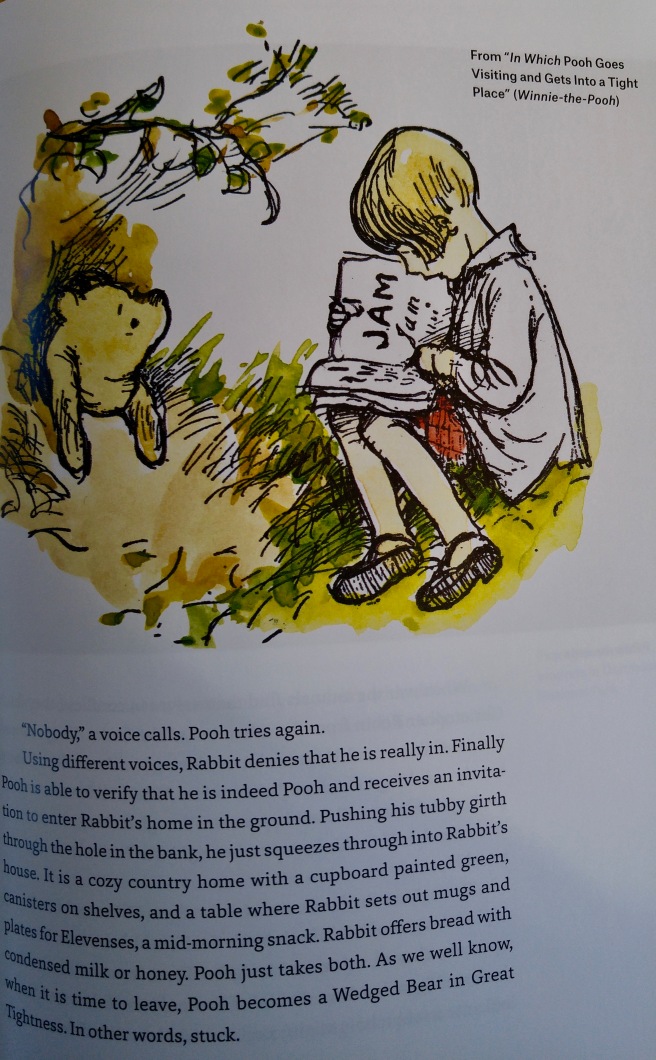My sister knows me well. And so this summer she gifted me a copy of Kathryn Aalto’s The Natural World of Winnie-the-Pooh: A walk through the forest that inspired the Hundred Acre Wood.

My relationship with Pooh began as a child, though I can’t remember if my sister or mother read the stories to me or if I first meet him on my own. It doesn’t matter. What’s more important is that I had the opportunity to meet him and to stay in touch ever since.

Our relationship continued when I took a children’s literature course as a high school senior and after reading and writing about the books, I sketched characters from several stories including A.A. Milne’s Winnie-the-Pooh to complete an assignment. My framed collage still decorates a wall in my studio. And later, I met Pooh again through The Tao of Pooh here I listened more closely to his lessons about life. When I needed to interpret a song for a sign language class, it was to Pooh I turned: Kenny Loggin’s “House at Pooh Corner.” And Pooh was a dear friend when our sons were young and the oldest formed his own relationship with the residents of the Hundred Acre Wood.

And so it was with great joy that I opened Aalto’s book and immediately related to her dedication: “To the walkers of the world who know the beauty is in the journey.”

When a friend noted that Winnie-the-Pooh is 90 years old today, I knew that this had to be the Book of November. Alan Alexander Milne published When We Were Young and A Gallery of Children in the two years prior to 1926 and followed with The House at Pooh Corner in 1928. All are as meaningful today as they were then–perhaps more so.
Aalto is an American landscape designer, historian and writer who lives in Exeter, England. I know it’s not good to covet someone else’s life, and yet . . . I do.
Her book begins with biographical background about Milne and how he came to be at Ashdown Forest and the Five Hundred Acre Wood. I think one of my favorite facts that she shares is that while at boarding school, his mother sent care packages that included bunches of flowers grown in her garden. Upon receiving them, he was pulled home by the sight and scent. Perhaps secretly, my sons would appreciate that, but they’d never let on.
States Aalto: “We value the books for simple expressions of empathy, friendship, and kindness. The stories are classics as they express enduring values and open our hearts and minds to help us live well. But as I read about Milne and walked around England with my children, I saw how they also tell another story: the degree to which the nature of childhood has changed in the ninety years since Milne wrote the stories. There is less freedom to let children roam and explore their natural and urban environments. There are more digital distractions for our children that keep them indoors and immobile, and heightened parental fears that do so as well.”
With that, I am reminded of a childhood well spent exploring the environs of our Connecticut neighborhood and beyond and not returning home until we heard Mom shout our names from the back door. (Or a certain next door neighbor told me that my mother was calling.)

While C.R.’s explorations with his stuffed animals became the muses for his father’s stories, the landscape also provided inspiration.
That landscape still exists, though time has had a way with it. Aalto takes us there through her photographs and words. She begins with a visit to the farm, village of Hartfield, and the forest located steps to the south. Referring to the Ashford Forest, she comments: “It is still a place of solitude where people can walk half a day without meeting another person. There are no overt signs pronouncing your arrival in Pooh Country. There are no bright lights or billboards, no £1 carnival rides, no inflatable Eeyores, Owls, or Roos rising and falling in dramatic flair. There are no signs marking the dirt lane where Milne lived, nor pub grub with names like “Milne Mash and Peas” or a “Tigger’s Extract of Malt Cocktail” on ice. A quiet authenticity–historical, literary, and environmental–has settled over the landscape.” Ah, yes. A place to simply be and breathe and take it all in.

A photograph of C.R.’s secret hideaway in a tree reminds us that the stories are about real people and real places and based on real life events, all with a dash of real imagination. Aalto examines every aspect of this.
A week ago today, while exploring a similar woodland in New Hampshire with a dear friend, I convinced her to step inside a tree cavity, much the way the real Christopher Robin used to do a Cotchford Farm. At heart, we can all be kids again.

I love that Aalto provides us with a closer look at the flora and fauna of the forest. From flowers and ferns to birds, butterflies, moths, damselflies and dragonflies, and red tail deer, she gives us a taste of C.R. and Pooh’s world.

And she reminds us to get out and play, including rules for Poohsticks. I think it is more important than ever that all members of our nation step outside, find a Pooh bridge, drop a stick and run to the other side. As Aalto says in rule #9: “Repeat over and over and over and . . . ”

I also like that she mentions one special visitor to Ashdown Forest, who spent many hours examining carnivorous sundews.

I’m rather excited by that because just yesterday I discovered sundews, though rather dried up, growing on our six-acre woodland. We’ve lived in this house for 24 year and I’ve never spotted these before. The land is forever sharing something “new” with me and I’m happy to receive each lesson.

I’m also thankful for a feisty faerie with whom I share this outdoor space. Sometimes her statements are dramatic and I can only imagine the cause of her recent frustration.

It’s not too late to revisit your inner Pooh. To take the journey. And while you are there, I highly encourage you to get to know him and his place through The Natural World of Winnie-the-Pooh by Kathryn Aalto.
P.S. Thanks Lynn 😉
The Natural World of Winnie-the-Pooh, first edition, by Kathryn Aalto, © 2015

Leigh, marvelous!
LikeLike
Thank you, sir. Heard you visited my guy the other day.
LikeLike
Me thinks the little faerie needs some friends such as WTP has in the Hundred Acre Woods.hehehe
LikeLiked by 1 person
Indeed. That might calm her down.
LikeLike